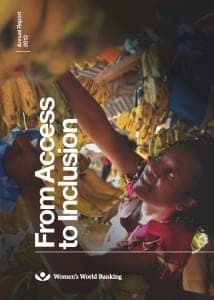
In 2013, the final year of our three-year Strategic Plan, we brought this feeling of pride to more women all over the world. In the last three years we have completed 27 research studies on the lives of low-income women; reached 1.2 million clients in 24 financial institutions with new products; and trained more than 200 leaders of financial institutions. We are pleased to illustrate the impact behind these numbers throughout the pages of this report.
[Tweet “Women’s World Banking’s 2013 Annual Report: From Access to Inclusion”]
2013 brought new opportunities to expand our work on an unprecedented scale in Africa where more and more commercial banks are recognizing what Women’s World Banking has always known—the tremendous market opportunity in serving low-income women. We developed a savings product with Diamond Bank, one of the largest commercial banks in Nigeria and began new relationships with commercial banks in Malawi and Tanzania.
Continuing this theme of growth, we brought several innovative products to global scale in 2013. Women’s World Banking has long believed in the potential of microinsurance to provide a profitable business opportunity for financial institutions as well as a critical safety net for low-income families in crisis. Our successful Caregiver microinsurance product, first introduced in Jordan, is expanding to Peru, Uganda, Morocco, and Mexico. Similarly, youth savings, first introduced in Mongolia and the Dominican Republic, has now expanded to India, Nigeria and Ethiopia, providing girls and boys with an introduction to financial education and to the power of a savings account.
Of course these products cannot be sustainable without two essential ingredients, both areas where Women’s World Banking showed growth in 2013: financial education so women can understand the products they are using and strong leadership in the financial institution to drive innovation to serve the women’s market.
We are proud of the positive impact of our work in 2013. But we think of that woman in Malawi every day—every woman deserves the financial products and services that can bring her security, prosperity and dignity. In the next five years, we will provide 5 million more clients with these valuable financial tools. Please join us in this journey.




